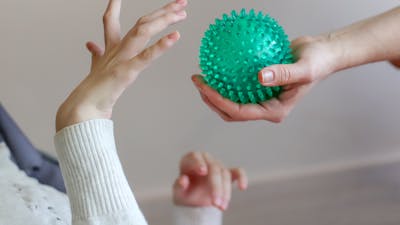Accelera has licensed the Wyss Institute’s stochastic resonance technology to develop fully wearable medical devices that support function in patients with cerebral palsy and other neurological conditions.
The Problem
Cerebral palsy is the most common movement disorder in childhood: nearly 10,000 babies are born with cerebral palsy each year in the US, and it about 764,000 people suffer from its effects. Patients with cerebral palsy have problems controlling the muscles in various parts of their body, which makes it difficult for them to walk, maintain their posture, and manipulate things with their hands. In severe cases, cerebral palsy can also cause intellectual disabilities, seizures, and problems with vision, hearing, and speech. There is no cure for cerebral palsy, and while treatments like surgery, medication, physical therapy, and braces or wheelchairs can help patients manage the disease, some require intensive, lifelong care.
Our Solution
The Wyss Institute’s stochastic resonance technology is being used to create wearable devices for patients that can be worn like a bracelet or anklet and deliver gentle, random vibrations to the muscles. These unobtrusive devices can be worn while a patient is going about their normal activities, and improves their ability to control their movements.
Product Journey
Wyss Core Faculty member Jim Collins, Ph.D. explored the principle of stochastic resonance and its application to biological systems for over a decade. In addition to demonstrating that stochastic resonance stimulation can improve basic touch and joint angle sensation, Collins and his team also showed that it had promise for more complex sensorimotor human functions such as balance, mobility, and motor learning. The devices delivering this stimulation took many forms, including stimulating braces, wraps and supports, and a vibrating mattress that was licensed by Prapela.

These results caught the attention of Mike Wing and Karin Gregory, who were interested in building a company to address a significant unmet need in health. They formed the company Accelera, licensed the technology from the Wyss, and started working to identify the population of patients who would most benefit from it. Olivier Rolin, M.D., PhD., an Assistant Professor at Richmond Children’s Hospital in Virginia, heard about their work through Niemi and reached out to them with the idea of trying the technology on some of his patients with cerebral palsy and other neurological disorders.
Wing sent some prototype devices to Rolin, and soon after, Rolin sent back a video of a two-year-old patient with spastic cerebral palsy who was unable to open his hand. When Accelera’s device was put on the child’s wrist, he was successfully able to open and close his hand, and could even pick objects up. Seeing such a dramatic response galvanized the Accelera team to focus on cerebral palsy as the first condition to target with their device. Additional clinical studies were organized by Rolin in Virginia in which virtually every patient showed improvement when using the device.
Impact
Accelera’s device, which consists of a set of fully wireless bands that can be worn around the wrist or ankle and an accompanying smartphone app to control output levels, was registered with the FDA as a class 2, exempt device in 2021 . The company has received three separate grants from the Maine Technology Institute for research and development, product design, and clinical evaluation, and in June 2021 was named a winner in the Center for Advancing Innovation’s global 2021 Innovate Children’s Health Challenge. In preparation for its full product launch, Accelera is currently working with physical rehabilitation clinics and hospitals to introduce clinicians to its technology’s benefits. In addition to cerebral palsy, Accelera plans to pursue approval for additional neurological disorders such as neuropathy, essential tremors, balance problems, and supporting proprioception following joint injury.
